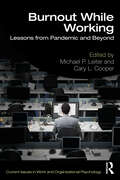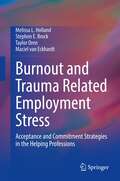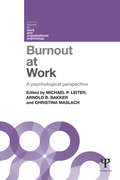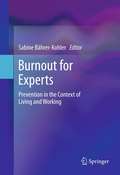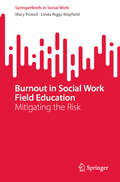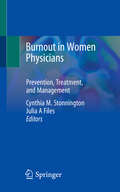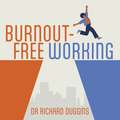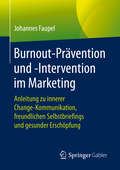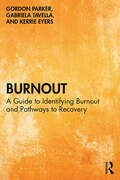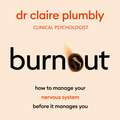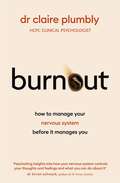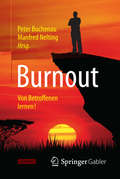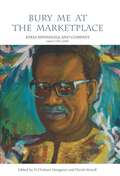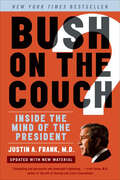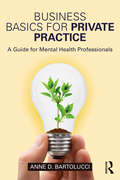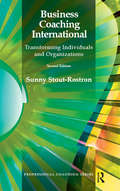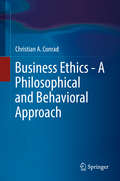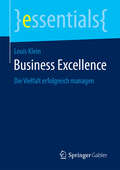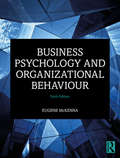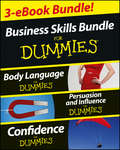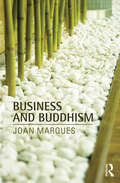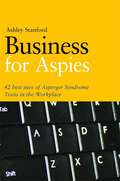- Table View
- List View
Burnout While Working: Lessons from Pandemic and Beyond (Current Issues In Work And Organizational Psychology Ser.)
by Cary L. Cooper Michael P. LeiterThis book offers an extensive look into the ways living through the COVID-19 pandemic has deepened our understanding of the crises people experience in their relationships with work. Leading experts explore burnout as an occupational phenomenon that arises through mismatches between workplace and individuals on the day-to-day patterns in work life. By disrupting where, when, and how people worked, pandemic measures upset the delicate balances in place regarding core areas of work life. Chapters examine the profound implications of social distancing on the quality and frequency of social encounters among colleagues, with management, and with clientele. The book covers a variety of occupational groups such as those in the healthcare and education sectors, and demonstrates the advantages and strains that come with working from home. The authors also consider the broader social context of working through the pandemic regarding risks and rewards for essential workers. By focusing on changes in organizational structures, policies, and practices, this book looks at effective ways forward in both recovering from this pandemic and preparing for further workplace disruptions. A wide audience of students and researchers in psychology, management, business, healthcare, and social sciences, as well as policy makers in government and professional organizations, will benefit from this detailed insight into the ways COVID-19 has affected contemporary work attitudes and practices.
Burnout and Trauma Related Employment Stress: Acceptance and Commitment Strategies in the Helping Professions
by Stephen E. Brock Melissa L. Holland Taylor Oren Maciel van EckhardtBurnout and trauma related employment stress (TRES), which includes compassion fatigue, secondary traumatic stress, and vicarious trauma, are increasing in prevalence as attrition rates, mental health disturbances, and suicide rates are climbing for those in the helping professions. This book highlights the imperative for prevention and early intervention using acceptance and commitment strategies. It includes cognitive, acceptance, and mindfulness techniques to assist the individual in achieving goals through values-based living. Among the topics discussed: Definitions of Burnout and TRESPrevalence rates of burnout and TRES in the helping professionsMindfulness and acceptance practicesDefusion and cognitive techniquesValues based goal settingOrganizational responsibilities and strategiesAssessment resources Burnout and Trauma Related Employment Stress will be a valuable resource for clinicians working with those experiencing the symptoms of TRES and burnout, as well as the individuals themselves.
Burnout at Work: A psychological perspective
by Michael P. Leiter Christina Maslach Arnold B. BakkerThe psychological concept of burnout refers to long-term exhaustion from, and diminished interest in, the work we do. It’s a phenomenon that most of us have some understanding of, even if we haven’t always been affected directly. Many people start their working lives full of energy and enthusiasm, but far fewer are able to maintain that level of engagement. Burnout at Work: A Psychological Perspective provides a comprehensive overview of how the concept of burnout has been conceived over recent decades, as well as discussing the challenges and possible interventions that can help confront this pervasive issue. Including contributions from the most eminent researchers in this field, the book examines a range of topics including: The links between burnout and health How our individual relationships at work can affect levels of burnout The role of leadership in mediating or causing burnout The strategies that individuals can pursue to avoid burnout, as well as wider interventions. The book will be required reading for anyone studying organizational or occupational psychology, and will also interest students of business and management, and health psychology.
Burnout for Experts: Prevention in the Context of Living and Working
by Sabine Bährer-KohlerWherever people are working, there is some type of stress--and where there is stress, there is the risk of burnout. It is widespread, the subject of numerous studies in the U.S. and abroad. It is also costly, both to individuals in the form of sick days, lost wages, and emotional exhaustion, and to the workplace in terms of the bottom line. But as we are now beginning to understand, burnout is also preventable. Burnout for Experts brings multifaceted analysis to a multilayered problem, offering comprehensive discussion of contributing factors, classic and less widely perceived markers of burnout, coping strategies, and treatment methods. International perspectives consider phase models of burnout and differentiate between burnout and related physical and mental health conditions. By focusing on specific job and life variables including workplace culture and gender aspects, contributors give professionals ample means for recognizing burnout as well as its warning signs. Chapters on prevention and intervention detail effective programs that can be implemented at the individual and organizational levels. Included in the coverage: · History of burnout: a phenomenon. · Personal and external factors contributing to burnout. · Depression and burnout · Assessment tools and methods. · The role of communication in burnout prevention. · Active coping and other intervention strategies. Skillfully balancing scholarship and accessibility, Burnout for Experts is a go-to resource for health psychologists, social workers, psychiatrists, and organizational, industrial, and clinical psychologists.
Burnout in Social Work Field Education: Mitigating the Risk (SpringerBriefs in Social Work)
by Mary Powell Linda Riggs MayfieldThis book informs social work students about the context and potential for burnout in their field experience, their first work with clients, and equips them to recognize, prevent, and address it. With its emphasis on role ambiguity and self-care based on current research, the volume uniquely fills the gap in available texts and prepares them for successful professional practice with personal mental health. Job burnout and self-care have received attention in research and education in social work and other caring professions, but social work students must successfully complete managed learning assignments in the field before they can become social workers, and those experiences can put the student at risk for burnout. Until very recently, however, student burnout has been a 'silent' issue in the profession and the literature. With this compact book, readers learn the risks of burnout in field assignments for students and new professionals, the organizational andpersonal factors that contribute to it, appropriate self-care strategies to reduce its incidence, and effective coping strategies to limit its effect. Stakeholders gain understanding about burnout incidence, prevention, and self-care that prepares them to take appropriate preventive and prescriptive action. Burnout in Social Work Field Education: Mitigating the Risk is a timely and essential resource for social work instructors, students, field interns, instructors, and supervisors. It can serve as a supplementary text to aid students in understanding what factors will increase their risk of burnout and help them identify which coping strategies are most likely to be effective, based on research. It is a highly desirable complementary text for adoption in social work courses and in-service education in early social work practice. The book also should interest administrators in social service agencies and presenters of in-service education opportunities for social workers and social work educators.
Burnout in Women Physicians: Prevention, Treatment, and Management
by Cynthia M. Stonnington Julia A FilesThis book is the first to dissect the factors contributing to burnout that impact women physicians and seeks to appropriately address these issues. The book begins by establishing the differences in epidemiology between female physicians and their male counterparts, including rates of burnout, depression and suicide, chosen fields, caregiving responsibilities at home, career tradeoffs in dual physician marriages, patient satisfaction and outcomes, academic rank, leadership positions, salary, and turnover. The second part of the book explores the drivers of physician burnout that disproportionately affect women, each chapter beginning with a case vignette. This section covers many issues that often go unrecognized including unconscious bias, sexual harassment, gender role conflicts, domestic responsibilities, depression, addiction, financial stress, and the impact related to reproductive health such as pregnancy and breastfeeding. The book concludes by focusing on strategies to prevent and/or mitigate burnout among individual women physicians across the career lifespan.This section also includes recommendations to change the culture of medicine and the systems that contribute to burnout.Burnout in Women Physicians is an excellent resource for physicians across all specialties who are concerned with physician wellness and burnout, including students, residents, fellows, and attending physicians.
Burnout vermeiden - Berufsfreude gewinnen: Praxisleitfaden zum Restart für Lehrer und pädagogische Fachkräfte
by Désirée LindeDieses Buch zeigt Ihnen Wege, wie Sie sich in Stress-Situationen stabiler fühlen und souveräner verhalten können. Es führt Sie zu einem neuen, psychologisch besseren und fürsorglicheren Umgang mit sich selbst und einer harmonisch ausbalancierten Lebensführung. Mit dieser Basis können Sie Ihre beruflichen Anforderungen stressfreier managen. Sie erfahren, wie Sie beispielsweise Ihre Arbeit ohne Schüler, d. h. Ihre Vorbereitungen, Korrekturen, Team- und Elternarbeit, effektiver organisieren können. Anhand von vielen authentischen Beispielen geht es dann in der Schularbeit um erfolgreiche Klassenführung, Motivationsmöglichkeiten, sowie Vorbeugung von Unterrichtstörungen und Aggressionen und Intervention bei ihrem Auftreten. In einem Anwendungskapitel haben Sie Gelegenheit, gewünschte neue Programmierungen für einen glücklicheren Berufsalltag selbst zu erarbeiten.
Burnout-Free Working: Your Expert Guide to Thriving in a Stressful Workplace
by Richard DugginsAre you keen to banish burnout for good? Burnout-Free Working is written by Dr Richard Duggins - a leading expert and trainer on preventing burnout in high stress jobs, also known as 'The Doctor's Doctor'. In this book he reveals the secrets of his trade for the first time. With a wealth of proven tools for burnout-free working, Dr Duggins covers all you need to know, including:- Spotting early signs of burnout - Steering clear of 'the burnout cliff'- Tackling 'Keep calm and carry on' culture- Detoxifying workplace environments- Dealing with trauma at work- Moving from Stress to Decompress- Strategies to support colleagues Dr Duggins breaks down common burnout myths (it's really not about building resilience!) and encourages us all to shift our thinking away from burnout recovery, to instead living and working in a way that avoids burnout before you even get close.
Burnout-Prävention und -Intervention im Marketing: Anleitung zu innerer Change-Kommunikation, freundlichen Selbstbriefings und gesunder Erschöpfung
by Johannes FaupelIn diesem Buch erfahren Sie alles über Burnout-Prävention im Marketing Johannes Faupel behandelt in seinem Buch „Burnout-Prävention und -Intervention im Marketing“ folgende Themen: Wie Überforderungsmuster entstehenBurnout-Prävention und -InterventionUnerlässlich: Briefing und AuftragsklärungGesunde ErschöpfungWie es im Burnout-Kreislauf aussiehtKampagne entwickelnGesundheitsmanagement und gesunde ArbeitsweisenNeue Filme einspielenPseudo-Plausibilitäten, absurde Aufgaben und das Komplexitäts-ParadoxonDas Marathonprinzip und Grenzen erkennen Es richtet sich in erster Linie an Menschen, die in der Marketingbranche tätig sind und Erschöpfungs- und Burnoutsymptomen rechtzeitig bekämpfen wollen. Lernen Sie, auf Ihren Körper zu hören und erkennen Sie Warnsignale für Depressionen im Job Autor Johannes Faupel lehrt Sie in seinem Buch:Wie Sie sich aktiv mit den Rückmeldungen Ihres eigenen Körpers auseinandersetzenWie Sie diese richtig interpretierenWie Sie daraus einen gesunden und individuell passenden Arbeitsstil für sich entwickeln Lernen Sie Schritt für Schritt, wie Sie auf Ihren Körper hören und Burnouts vorbeugen. Nur so können Sie erste Anzeichen einer Depression im Beruf frühzeitig erkennen und rechtzeitig mit der Stressbewältigungstherapie beginnen, um dem Burnout in Ihrem Marketingalltag gezielt vorzubeugen.
Burnout: A Guide to Identifying Burnout and Pathways to Recovery
by Gordon Parker Kerrie Eyers Gabriela TavellaBurnout: A Guide to Identifying Burnout and Pathways to Recovery is the first complete self-help guide to burnout, based on groundbreaking new research. Burnout is widespread among high achievers in the workplace, and the problem is becoming more prevalent and profound in its impact. This book contains new evidence-based tools for readers to work out for themselves whether they have burnout and generate a plan for recovery based on their personal situation. Chapters show readers how to recognise their own burnout patterns and how far they may have travelled into burnout territory, and provide research-based management approaches to help them regain their passions and build their resilience. Offering fascinating new insights into the biology of burnout, and stories from people who have rebounded from it, the book acts as a complete guide for anyone who suspects they may have burnout, for their friends and families, and for health professionals and employers.
Burnout: How to Manage Your Nervous System Before it Manages You
by Dr Claire PlumblyOur human nervous system has the power to cope with high stress but not when it's been ground down by the relentless stimuli of today's world. Over time, these persistent demands leave us burnt out because our nervous system is stuck in survival mode. In this mode, we have reduced capacity for rational thinking and less capacity to care. It becomes hard to make decisions, rest, solve problems, be mindful and set boundaries.Drawing on polyvagal theory and her professional insights as a trauma therapist working with clients experiencing anxiety, trauma and burnout, Clinical Psychologist Dr Claire Plumbly will help you understand:- Why stress is different from burnout- How burnout stifles your ability to interact, think clearly and be productive or creative.- Why you get stuck in burnout and cannot 'think' your way out of it or engage in activities you know could help you.- Cultural beliefs and psychological patterns that cause burnout- How to soothe your nervous system back to full capacity using techniques and compassion.By the end of this book, you will have tools to thrive amidst the challenges of modern life, at work, at home and through positive interactions and relationships.
Burnout: How to Manage Your Nervous System Before it Manages You
by Dr Claire Plumbly'There is only one book on burnout that I will be recommending - this one. We need one in every office and every staff room around the world.' Dr Julie Smith, bestselling author of Why Has Nobody Told Me This BeforeOur human nervous system has the power to cope with high stress but not when it's been ground down by the relentless stimuli of today's world. Over time, these persistent demands leave us burnt out because our nervous system is stuck in survival mode. In this mode, we have reduced capacity for rational thinking and less capacity to care. It becomes hard to make decisions, rest, solve problems, be mindful and set boundaries.Drawing on polyvagal theory and her professional insights as a trauma therapist working with clients experiencing anxiety, trauma and burnout, Clinical Psychologist Dr Claire Plumbly will help you understand:- Why stress is different from burnout- How burnout stifles your ability to interact, think clearly and be productive or creative.- Why you get stuck in burnout and cannot 'think' your way out of it or engage in activities you know could help you.- Cultural beliefs and psychological patterns that cause burnout- How to soothe your nervous system back to full capacity using techniques and compassion.By the end of this book, you will have tools to thrive amidst the challenges of modern life, at work, at home and through positive interactions and relationships.
Burnout: Von Betroffenen lernen!
by Peter Buchenau Manfred NeltingDie Leser des Buches werden von 13 Burnout-betroffenen Menschen in ihre Lebenserzählungen mitgenommen. Diese Erzählungen konnten sie alle erst jetzt aus der rückwärtigen Perspektive aufschreiben, obwohl bei allen so etwas wie eine Ahnung der Zusammenhänge während des Burnout-Prozesses anklang. Zu schmerzlich wäre es gewesen, sich einzugestehen, dass die eingeschlagene Richtung nicht stimmt bzw. den jeweiligen Alltag nicht schaffen zu können, da wir in einem Burnout-Prozess unserer Gesellschaft meist die Deutungshoheit lassen: Du bist zu schwach, Du bist ein Versager, andere schaffen das, das musst Du auch schaffen, denk dran, was Du dafür investiert hast!' Doch im Nachhinein haben sich alle erlaubt, selbst zu deuten, was sie erlebt haben, und bezeichnen die Erfahrung im Burnout als entscheidend wichtiges Erleben in ihrem Leben hin zu einem wesensnäheren Alltag. Die Retroperspektive erlaubt es allen den Prozess als wichtige Richtungsänderung und Reifung zu sehen und doch hätten alle sehr gerne ihren Burnout-Prozess frühzeitiger verlassen, hätten sie gewusst wie. Alle haben aber auch verstanden und dargestellt, warum es bei ihnen zum Burnout kommen ,musste'. Von Betroffenen lernen heißt also auch die Frage zu beantworten, inwieweit sich ein Burnout-Prozess frühzeitig bemerken lässt und ob es bewährte Exit-Strategien dafür gibt. Des weiteren kommt die Frage auf, ob es eine Burnout-Prävention geben kann. Dieses Buch gibt daher 13 persönliche Antworten.
Burton Malkiel's A Random Walk Down Wall Street (The Macat Library)
by Nicholas BurtonBurton Malkiel’s 1973 A Random Walk Down Wall Street was an explosive contribution to debates about how to reap a good return on investing in stocks and shares. Reissued and updated many times since, Malkiel’s text remains an indispensable contribution to the world of investment strategy – one that continues to cause controversy among investment professionals today. <P><P>At the book’s heart lies a simple question of evaluation: just how successful are investment experts? The financial world was, and is, full of people who claim to have the knowledge and expertise to outperform the markets, and produce larger gains for investors as a result of their knowledge. But how successful, Malkiel asked, are they really? Via careful evaluations of performance – looking at those who invested via ‘technical analysis’ and ‘fundamental analysis’ – he was able to challenge the adequacy of many of the claims made for analysts’ success. Malkiel found the major active investment strategies to be significantly flawed. Where actively managed funds posted big gains one year, they seemingly inevitably posted below average gains in succeeding years. By evaluating the figures over the medium and long term, indeed, Malkiel discovered that actively-managed funds did far worse on average than those that passively followed the general market index. <P><P>Though many investment professionals still argue against Malkiel’s influential findings, his exploration of the strengths and weaknesses of the argument for believing investors’ claims provides strong evidence that his own passive strategy wins out overall.
Bury Me at the Marketplace: Es'kia Mphahlele and Company. Letters 1943-2006
by N Chabani Manganyi and David AttwellWhen Chabani Manganyi published the first edition of selected letters twenty-five years ago as a companion volume to Exiles and Homecomings: A Biography of Es’kia Mphahlele, the idea of Mphahlele’s death was remote and poetic. The title, Bury Me at the Marketplace, suggested that immortality of a kind awaited Mphahlele, in the very coming and going of those who remember him and whose lives he touched. It suggested, too, the energy and magnanimity of Mphahlele, the man, whose personality and intellect as a writer and educator would carve an indelible place for him in South Africa’s public sphere.That death has now come and we mourn it. Manganyi’s words at the time have acquired a new significance: in the symbolic marketplace, he noted, ‘the drama of life continues relentlessly and the silence of death is unmasked for all time’. The silence of death is certainly unmasked in this volume, in its record of Mphahlele’s rich and varied life: his private words, his passions and obsessions, his arguments, his loves, hopes, achievements, and yes, even some of his failures. Here the reader will find many facets of the private man translated back into the marketplace of public memory.Despite the personal nature of the letters, the further horizons of this volume are the contours of South Africa’s literary and cultural history, the international affiliations out of which it has been formed, particularly in the diaspora that connects South Africa to the rest of the African continent and to the black presence in Europe and the United States.This selection of Mphahlele’s own letters has been greatly expanded; it has also been augmented by the addition of letters from Mphahlele’s correspondents, among them such luminaries as Langston Hughes and Nadine Gordimer. It seeks to illustrate the networks that shaped Mphahlele’s personal and intellectual life, the circuits of intimacy, intellectual inquiry, of friendship, scholarship and solidarity that he created and nurtured overthe years. The letters cover the period from November 1943 to April 1987, forty-four of Mphahlele’s mature years and most of his active professional life. The correspondence is supplemented by introductory essays from the two editors, by two interviews conducted with Mphahlele by Manganyi and by Attwell’s insightful explanatory notes.
Bush on the Couch: Inside the Mind of the President
by Justin A. FrankWith the Bush administration in permanent crisis, a renowned Washington psychoanalyst updates his portrait of George W.'s public persona—and how it has damaged the presidency.Insightful and accessible, courageous and controversial, Bush on the Couch sheds startling new light on George W. Bush's psyche and its impact on the way he governs, tackling head-on the question few seem willing to ask: Is our president psychologically fit to run the country? With an eye for the subtleties of human behavior sharpened by thirty years of clinical practice, Dr. Justin A. Frank traces the development of Bush's character from childhood through his presidency, identifying and analyzing his patterns of thought, action, and communication. The result is a troubling portrait filled with important revelations about our nation's leader—including disturbing new insights into:How Bush reacted to the 2006 Democratic sweep in Congress with a new surge of troops into IraqHis telling habits and coping strategies—from his persistent mangling of English to his tendency to "go blank" in the midst of crisisThe tearful public breakdown of his father, George H. W. Bush, and what it says about the former president's relationship to his prominent sonsThe debacle of Katrina—the moment when Bush's arrogance finally failed himWith a new introduction and afterword, Bush on the Couch offers the most thorough and candid portrait to date of arguably the most psychologically damaged president since Nixon.
Business Basics for Private Practice: A Guide for Mental Health Professionals
by Anne D. BartolucciBusiness Basics for Private Practice is a step-by-step guide to developing a successful practice from initial conceptualization and business plan to future growth for the true entrepreneur. Dr. Bartolucci draws from interviews with fellow mental health practitioners and experts in business-related fields to make even the most intimidating parts of practice easy to understand. Business Basics is written to give the feel of mentorship, and the author talks about lessons learned the hard way. She’s also included checklists and worksheets to help you stay organized and ready to meet the challenges of opening a private practice.
Business Cases in Organisation Behaviour and HRM: Perspectives from India (Springer Business Cases)
by Gopal P. MahapatraThis book provides perspectives on various dimensions of organizational behavior (OB) and human resource management (HRM) in an ever-changing world. The world has been experiencing disruptions and technological changes at an unprecedented level in the last two decades. This book is a collection of handpicked cases and teaching notes on the various critical dimensions of OB, such as organization transformation, leadership, organization culture, training and development, innovation, CSR, competencies for enhancing entrepreneurship, and women leadership. These dimensions have been covered extensively with an emphasis on COVID-19 pandemic in a few cases. While academicians can use this book to cover the critical concepts and dimensions of change, leadership, and innovation, they can highlight its relevance for young professionals in their journey of growth and development. Through these cases, the postgraduate students are likely to benefit enormously from the recent changes in various industries, MNCs, and Indian organizations operating during changing times. Overall, this book of OB & HRM cases is a great value addition to the management field, equally for the teachers, practitioners, and students. It is a valuable supplement to popular OB & HRM textbooks.
Business Coaching International: Transforming Individuals and Organizations (The\professional Coaching Ser.)
by Sunny Stout-RostronYou simply must read this book if you are serious about being a top-notch business coach. It is an excellent guide to best practices based on clear theory, experience and business wisdom.'- Carol Kauffman PhD, co-founder and Director of the Coaching and Positive Psychology Initiative at Harvard Medical School, and Co-Editor-in-Chief of Coaching: An International Journal of Theory Research and Practice. 'This is an extraordinarily thorough book. It covers a great range of practical guidance on matters that will concern the new coach and addresses a wide range of approaches to coaching while remaining firmly embedded in an experiential learning tradition.'- David Megginson, Professor of Human Resource Development, Sheffield Hallam University, UK
Business Ethics - A Philosophical and Behavioral Approach
by Christian A. Conrad Danica WebbThis textbook examines the extent to which moral values play a role as productive forces for the economy, and explores the effect of ethical and unethical Behavior on the economy. It shows how ethics improves productivity in the economy, and provides specific ethics tools for practical application for students and managers. Stemming from an overall interdisciplinary approach, and combining recent research results from sciences such as economics, business administration, Behavioral economics, philosophy, psychology and sociology, this textbook fills a gap in the literature on ethics in business. The book begins with the foundations of business ethics by defining business ethics, delineating its objectives, and discussing the importance of business ethics for business, the economy and society. Next, it presents the ethical evaluation approaches to enable the reader to evaluate economic Behavior ethically. It then explores ‘man in business’, and deals with such issues as Behavior, motivation, ethical orientation, and the presence or absence of a sense of justice. Following this is a discussion of the rules of the market and of questions such as: Does the market economy promote ethical Behavior or is there a conflict of goals between ethics and market economy? Do companies have a social responsibility? The book concludes with an analysis of the importance of ethics for productivity in the enterprise and in the economy, and presents ethics tools as the instruments with which management can promote ethical Behavior of their employees. Following a textbook structure, the book first derives knowledge from scientific studies that is relevant for students, and then summarizes the results. It explains ethical assessment approaches, and then gives an ethical assessment of economic Behavior using case studies. It uses roleplaying and games to explain the Behavior of people in relation to ethics.
Business Excellence: Die Vielfalt erfolgreich managen (essentials)
by Louis KleinIn diesem essential bringt Louis Klein die Praxis der g#65533;ngigen betrieblichen Erfolgsmodelle von Business Excellence in einer instrumentellen Gesamtperspektive zusammen. Dabei zeigt sich, wie vieles schon vorhanden ist und nur darauf wartet, angepackt zu werden, aber auch, dass es nach wie vor blinde Flecken gibt, vor allem, wenn es um den Menschen geht.
Business Psychology and Organizational Behaviour
by Eugene McKennaBusiness Psychology and Organizational Behaviour introduces principles and concepts in psychology and organizational behaviour with emphasis on relevance and applications. Well organised and clearly written, it draws on a sound theoretical and applied base, and utilizes real-life examples, theories, and research findings of relevance to the world of business and work. The new edition of this best-selling textbook has been revised and updated with expanded and new material, including: proactive personality and situational theory in personality; theory of purposeful work behaviour; emotional and social anxiety in communication; decision biases and errors; and right brain activity and creativity, to name a few. There are numerous helpful features such as learning outcomes, chapter summaries, review questions, a glossary, and a comprehensive bibliography. Illustrations of practice and relevant theory and research also take the reader through individual, group, and organizational perspectives. This is an essential textbook for undergraduates and postgraduates studying psychology and organizational behaviour. What is more, it can be profitably used on degree, diploma, professional, and short courses. It's also likely to be of interest to the reflective practitioner in work organizations.
Business Skills For Dummies Three e-book Bundle: Body Language For Dummies, Persuasion and Influence For Dummies and Confidence For Dummies
by Kate Burton Elizabeth Kuhnke Brinley PlattsBusiness Skills For Dummies eBook bundle is a collection of three full length books rolled into one convenient bundle giving you the skills to be a confident and assured player in the business world and beyond! Actions really do speak louder than words. If you are puzzled by other people or want to improve the impression you give, having an insight into body language is key. Body Language For Dummies body reveals what people really mean, and how you can use your body and your expressions to make a positive impact. Many people want to gain trust or support in business and throughout life, but the true skill is doing so in a charming fashion! Whether you're convincing the boss about your much-deserved promotion or a busy restaurateur to offer a better table, Persuasion and Influence For Dummies can help improve and increase your successes. Confidence For Dummies shows you how to understand confidence, and offers practical tips and techniques to build on your skills and improve your confidence in all areas of life.
Business and Buddhism
by Joan MarquesBusiness and Buddhism explores alternative ways of leading in the aftermath of the Great Recession and the many stories of fraud and greed that emerged. The book explores shifts in business perspectives as more value is placed on soft skills like emotional intelligence and listening, and introduces the reader to the principles in Buddhist philosophy that can be applied in the workplace. Buddhist practices are increasingly understood as spiritual, rather than religious per se. In fact, Buddhism is alternately referred to as a philosophy or psychology. In this book, Marques explores the value of applying the positive psychology of Buddhism to work settings. She outlines the ways in which it offers highly effective solutions to addressing important management and organizational behavior related issues, but also flags up critical areas for caution. For example, Buddhism is non-confrontational, and promotes detachment. How can business leaders negotiate these principles in light of the demands of modern day pressures? The book includes end of chapter questions to promote reflection and critical thinking, and examples of Buddhist leaders in action. It will prove a captivating read for students of organizational behavior, management, leadership, diversity and ethics, as well as business consultants.
Business for Aspies: 42 Best Practices for Using Asperger Syndrome Traits at Work Successfully
by Ashley StanfordMost workplaces are a frenzied swirl of social interaction - between employees and bosses, customers and clients, and anyone else present. People with a mental framework better suited to non-social tasks can often be overlooked and underutilised in such an environment, but this book explains exactly how those with Asperger Syndrome can get their talents recognised and become successful and indispensable employees. Following the DSM system and an easy to use format, Ashley Stanford addresses all of the issues that can arise once a person with AS secures employment, through the eyes of both employee and employer. Describing what might be expected of any employee, she offers helpful tips and workarounds not only to enable AS individuals achieve their fullest potential, but to take advantage of their strengths. In a positive and upbeat tone, she shows that with the right supports and strategies, it is possible to overcome the day-to-day challenges that trip up even the most savvy Aspie, including negotiating pay rises, employer/employee relationships, team meetings, career advancement, and choosing when to take vacation time. Drawing on her experience as CEO of a computer software company, she also suggests steps that employers and managers can take to improve the working environment for people with AS, and take advantage of their strengths to enable them to become outstanding employees. Business for Aspies will help people with AS take steps towards achieving happy, fulfilled and above all successful working lives. It will be of key interest to the employers, managers, partners, and families of people with AS.
